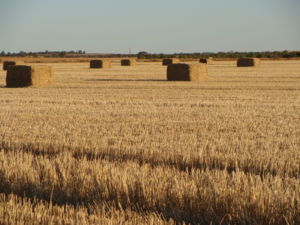A case for wheat straw for bioenergy!

West Australian agricultural cropping systems have wheat straw in abundance and at the moment we are not utilising this resource to our and our communities’ advantage. Wheat straw for bioenergy is a feasible option and Energy Farmers is working to develop projects that use wheat straw for bioenergy.
Current situation
Most farmers in Western Australia are cropping year in year out. Wheat, canola and lupins grown in rotation gives farmers the option of using alternative chemicals to take out weeds however, chemical resistance is still an issue. Burning crop residue is one option that farmers have to break that weed seed cycle but this is where we are missing the opportunity, the straw is literally going up in smoke.
When talking about burning we are only speaking about burning the harvest rows, not the whole paddock. During harvest farmers direct the straw coming off the sieves and rotors into a narrow row and then come back in March or April and burn these rows. Harvest trials carried out by Energy Farmers in 2011/12 in Mullewa show that straw yields of 1 tonne of straw for every 1 tonne of grain are achievable by bailing this harvest row with a conventional baler.
Capturing the resource
While conventional bailing is OK, we believe the best option to capture the resource is with the Glenvar Bale Direct. The Glenvar system is a baler connected to the back of the harvester. The system uses a belt to move the material from the harvester to the baler where it is baled normally. We understand the concerns farmers have with this system. Balers are complex, need skilled operators and using the system will probably slow down harvest. However, the advantage of using the system is that residue and weeds are collected in a one pass operation.
Wheat straw is typically around 15-25% moisture and has a net calorific value of around 13-15 MJ/kg. It contains nutrients such as potash however, has high amounts of silica which gives a relatively high ash content which and can lead to slagging and fouling problems during the combustion process.
Being a low density product, transport is an issue and one of the biggest limitations for any bioenergy project. Bale weights need to be kept to a maximum to alleviate this problem as well as sourcing straw for bioenergy projects close to where the facility is to be built.
Conversion technologies
Some of the emerging technology options to produce bioenergy and biofuels from wheat straw include:
Cellulose to ethanol – which is microbial or enzymatic conversion of biomass materials through fermentation. Fermentation involves microorganisms that use the fermentable sugars in biomass for food and in the process produces ethanol and other byproducts.
Pyrolysis – there are two types of pyrolysis fast and slow. Fast pyrolysis occurs between 300-550C and occurs in less than two seconds. The process produces a vapor which, once condensed turns into a fluid called pyrolysis oil. This oil can be used as a fuel source for boilers but needs to be further refined into transport fuels.
Slow pyrolysis occurs at around 400C and has longer residence times. The process releases the gases bound up in the biomass. These gases can be burnt to create heat or scrubbed (cleaned) to use in a gas fired motor driving a turbine.
Nutrient value
The nutrient value of the straw is also very important. If farmers are going to be removing straw from their paddocks then they will be also removing nutrients and these nutrient will need to be replaced. It does not make sense to us to replace these nutrients through fossil based fertilisers. Instead by-products of these conversion processes such as biochar can be used to replace the nutrients as well as pick up carbon credits through carbon storage or offsetting fossil based fertilisers.
Energy Farmers has been doing a lot of work on the feasibility of using wheat straw and other crop residues for bioenergy production. If you would like more information please contact us.

